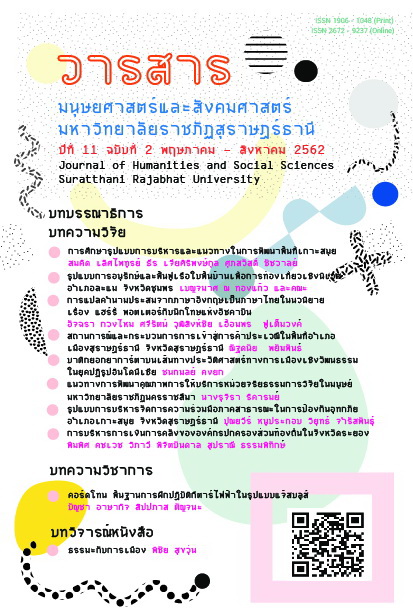A Model of Collaborative Public Management for Flood Preventive in Koh Samui Surat Thani
Main Article Content
Abstract
The purposes of this study were : (1) to explore the situation of collaborative public management for flood prevention in Koh Samui, Surat Thani (2) to examine public collaboration and factors causing the achievement of the public collaboration in flood prevention at Kho Samui, Surat-Thani, and (3) to seek an effective plan of public collaboration management for flood prevention at Kho Samui, Surat Thani. This study was a qualitative
research which recruited 25 key informants of government organization, local government, and civil society. This study was conducted by (1) structured interview (2) unstructured interview (3) non-participant observation, and (4) focus group.The results of the study found that (1) a model of collaborative public management for flood prevention in Koh Samui comprised three main managements as follows: (1) The strengths of central government were budget, equipment, motivation and knowledge to manage flood situation, and the weaknesses were no up-to-date data storage, delayed action to start solve flood protection, and lack of clear communication. On the other hand, Samui local government had authority to take action, good management, equipment, budget and network. However, the weaknesses were dependence on policies from the central government, lack of human resources, lack of communication to local network. (2) Local people were a significant element in collaborative management, i.e. powerful cooperation and network for assistance. On the other hand, the weakness points were lack of equipment, insufficient budget, no self-reliance owing to waiting for government assistance because of lack of knowledge, no data record and no information support, lack of communication. (3) Civil Society was a necessary component in collaborative management. The strengths were sufficient human resources, stable network, modern equipment, sufficient budget, storage system,
ability to motivate people, credible information, good management and consistent system. The weakness was a limitation of human resources. 2) Cooperation process inducing the successful public collaboration for flood prevention comprised (1) stimulating cooperation (2) determining collaboration 3) integrating cooperation (4) collaborative junction (5) negotiation (6) agreement (7) cooperation. Five factors triggering cooperation included
(1) environment factor (2) operations factor (3) cooperation factor (4) encouragement factor (5) resources factor
3) The results of qualitative analysis in collaborative public
management revealed the four processes of management, namely (1) stimulating cooperation (2) determining collaborative (3) integrating cooperation (4) collaborative junction. Three factors contributing to the cooperation
included (1) environment factor (2) operations factor (3) cooperation factor. The models of collaborative public management included (1) Jurisdiction-Based Management Model (2) Top-Down Model 3) Donor-Recipient Model (4) Contented Model. Finally, a model of collaborative public management for floodprevention was introduced into the group discussion process, resulting in seeking optimal public corporation management. The study suggested two factors that (1) increased three more cooperation process, and (2) factors contributing to the cooperation.
Article Details

This work is licensed under a Creative Commons Attribution-NonCommercial-NoDerivatives 4.0 International License.
All published manuscripts have been verified by peer-peer professors in the fields of humanities and social sciences. Reprinting of the article must be authorized by the editorial staff.
References
Benjamin, C. E., Brechin, S.R., & Thoms, C. A. (2011). Special issue on networking nature: Newtwork forms of organization in environment governance. Journal of Natural Resources policy research, 3(3),211-340
Coppola, D.P. (2007). Introduction to International Disaster Management. Burlington: Butterworth Heinemann.
Cook, A. H. (2009). Toward an emergency response report card: Evacuating the response to the 35W bridge collapse. Journal of Homeland Security and Emergency Management, 6(1), p.154- 177.
Department of Disaster Prevention and Mitigation Ministry of Interior. (2002). Strategic Planning Department of Disaster Prevention and Mitigation Ministry of Interior. Workshop on 18-20 November 2002, At Disaster Prevention and Mitigation Training Institute Bang Phun, Pathum Thani Province. (In Thai)
Janssen, M., Lee J., Bharosa N., & Gresswell A. (2010). Advances in multi - agercy disaster management: Key elements indisaster research. Information systems frontiers. 12(1)
Jha, A. K., Bloch, R., &Lamond, J., (2012). Cities and flooding: A guide to intergraded urban flood risk management for the 21st century. Washington, DC: The World Bank Publication.
Harshada, P., Michael, P., & Wilson, R. J. (2011). Factor of collaborative working: A framework for a collaboration model. Applied Ergonomics, 43(2012), p.1-26.
International Institute for Sustainable Development, (2011). A daily report of the third session of the global platform for disaster risk reduction, 141(1). Retrieved from http://www.IISD. CA/YMD/GPDRR/2011/
Kamolvej, Tavida. (2006). The Integration of Intergovernmental coordination and Information Management in Response to Immediate Crises: Thailand Emergency Management. Doctoral Dissertation, University of Pittsburgh.
Kiesler, S., & Cummings, J. N. (2002). What do we know about proximity and distance in work groups? A legacy of research. In Hinds, P., Kiesler, S. (Eds.), Distributed Work (pp.57- 80). Cambridge, Eng: MIT Press.
Kriengsak Chareonwongsak. (2001). Network Management: Important strategies for success in educational reform. Bnagkok: Success Media. (In Thai)
McGuire, M. and Schneck, D. 2010. What if Hurricane Katrina Hit in 2020? The Need for Strategic Management of Disasters. Public Administration Review. p.201-207
Montri Sirijanchuan. (1997). Leadership in community development. Community Development Program. Department of Sociology, Faculty of Humanities and Social Sciences. Rajabhat Institute Chiang Mai. (In Thai)
Parker, S. K., & Wall, T. D. (1996). Job design and modern manufacturing. In Warr, P. (Ed.), psychology at work (pp.333-358). London: Penguin Books.
Petak, W. J. & Atkisson, A. A. (1982). Natural hazard risk assessment and public policy. New York: Springer-Verlag.
Ring, Peter Smith and Van de Ven, Andrew H. (1994). Cite in Thomson, Ann Marie. 2006. “Collaboration Processes : Inside the Black Box.” Public Administration Review. (December 2006) Special Issue: 20-32.
Robert Agranoff & Michael McGuire. (2003). Collaborative Public Management. Washington, D.C. Georgetown University Press.
Water Crisis Prevention Center. (2012). Documents for the determination of repeated flooding areas in the south. Department of Water Resources Ministry of Natural Resources and Environment. Bangkok. (In Thai)
Yates D. & Paquett S. (2011). Emergercy knowledge management and social media teachnologies: A case study of the 2010 Haitian earthqualee.


